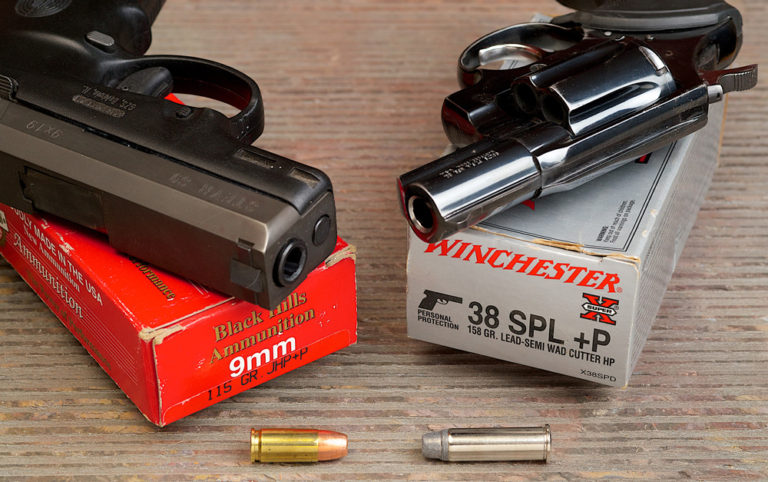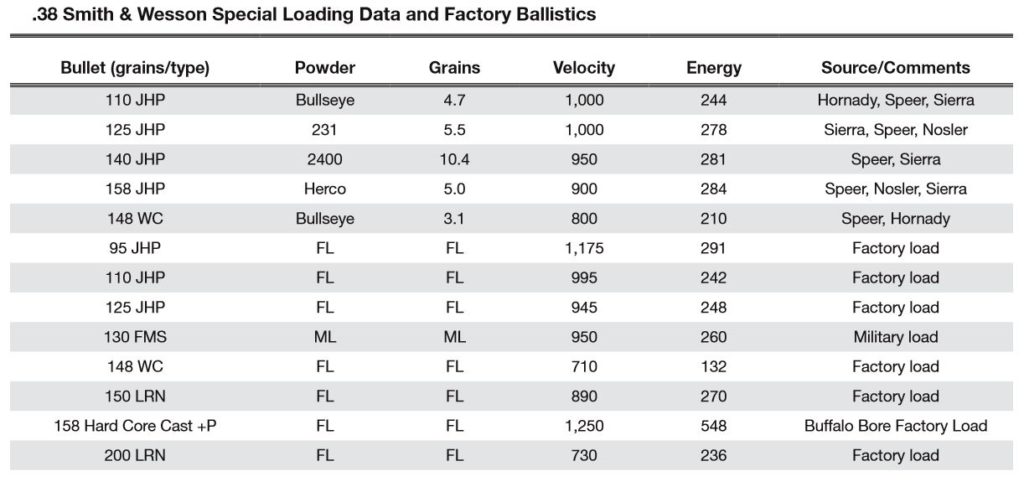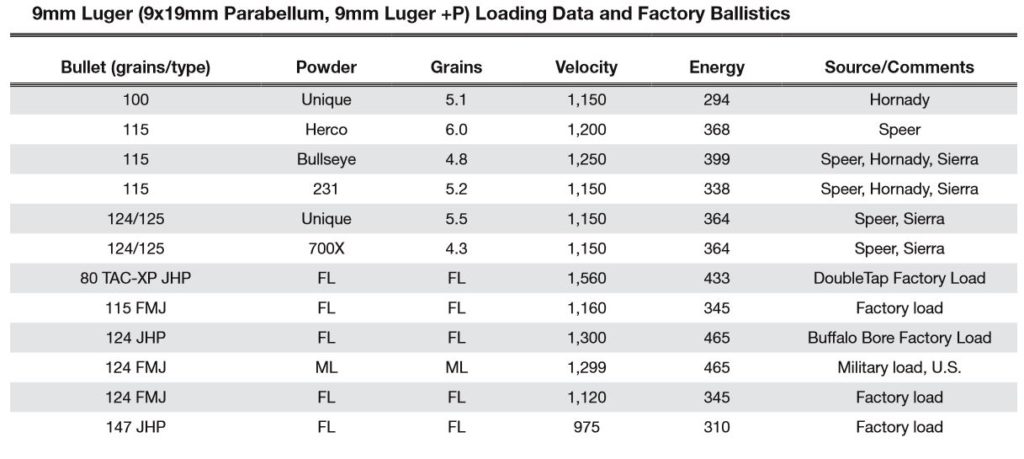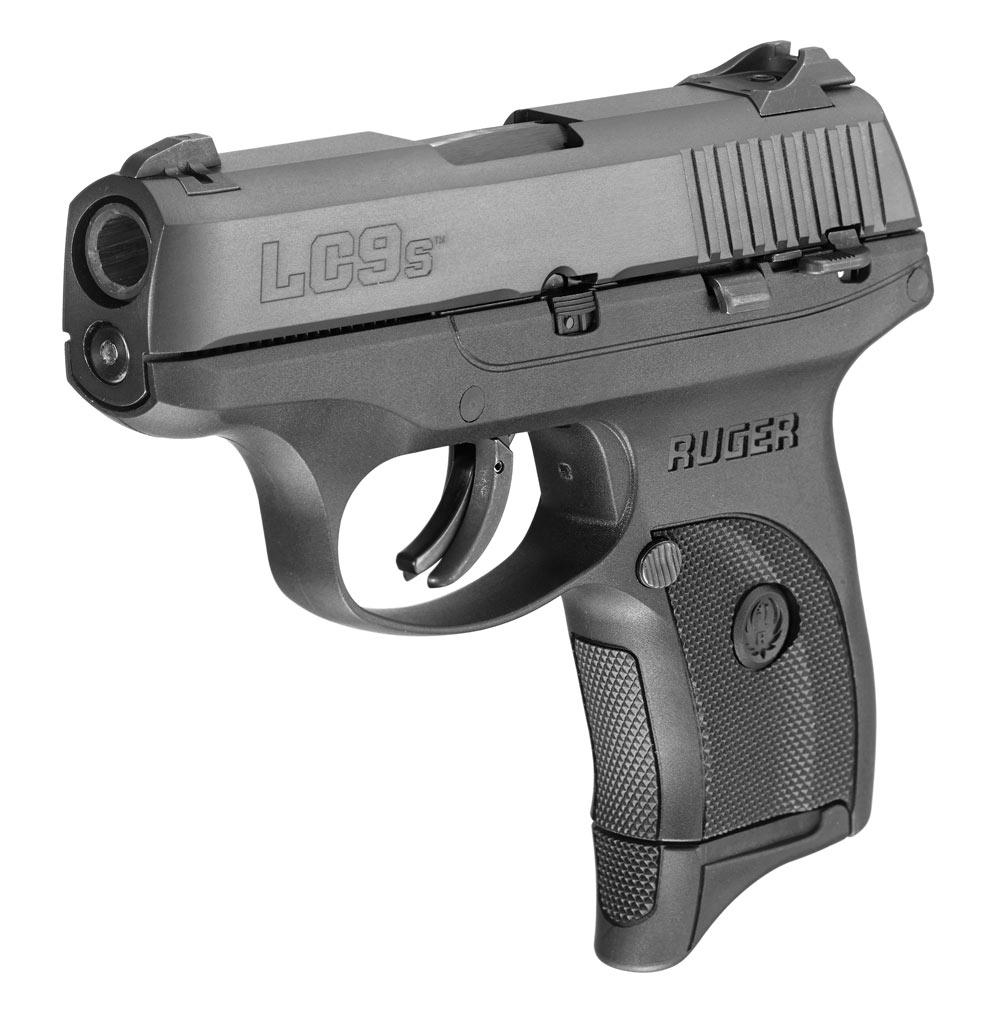
At first blush, there doesn't seem much to the .38 Special vs 9mm debate. Dig deeper and you'll find the cartridges both shine, but for much different reasons.
In .38 Special vs 9mm considerations:
- History and performance of the .38 Special
- History and performance of the 9mm
- Guns chambered for the cartridges
- Concealed carry performance
- Cartridges' versatility
- Ammunition availability and cost
Truth told, the .38 Special and 9mm aren’t a world away. Put your pitchforks down and quit lighting your torches, the implication isn’t the time-tested cartridges are carbon copies of each other. Not by a long shot. Their countries of origin are disparate, there’s plenty that separates them ballistically and, even as most novice shooters know, they are generally shot from different styles of handgun.

That said, if you sit down and rattle off the .38 Special and 9mm’s virtues, you’ll end up with nearly identical lists. To start, both are relatively versatile for medium-bore handgun cartridges. Shot out of the right gun, they’re accurate and mild recoiling. Both have more than proven their worth as self-defense options. And each is economical, plentiful and just plain fun to shoot.
From that perspective, they almost seem echoes of each other, maybe even a bit redundant. Heck, only two-thousandths of an inch separate their diameters — .357 in .38 Special and .355 for 9mm. So, everything laid bare, does it really matter who comes out on top in .38 Special vs 9mm?
Like so many aspects of the gun world, the answer isn’t as clear-cut as picking one or the other. Both are proven and excel at similar applications. But as is so often the case, each shines a bit more than the other for certain shooters.
.38 Special: The Persistent Revolver Cartridge
For a rather notorious cartridge, the .38 Long Colt had a particularly large influence on firearms and ammunition development. Its poor showing against Moro Rebels in the 1900s not only led to the eventual adoption of the .45 ACP and Colt 1911 by the U.S. Military, but also spurred the development of what would become one of the most prolific cartridges of the 20th Century — the .38 Special.

Starting life in 1899 as a black powder cartridge, the .38 Special was essentially an elongated .38 Long Colt that offered greater case capacity. In turn, the .38 Special generated greater velocities as well as shot heavier bullets, which added up to greater penetration potential — an asset sorely lacking in the .38 Long Colt. Proving extremely popular shot from the Smith & Wesson K-frame Military & Police revolver, the cartridge was soon switched over to the modern marvel of the day — smokeless powder.
Find Out More: Does The .45 Still Reign Supreme?
Given the respectable velocities for its time and the fact it was a kitten to shoot, the .38 Special became the primary service revolver caliber of most American law-enforcement agencies over the decades. Early on, the typical defensive load was a 158-grain lead semi-wadcutter hollowpoint, though later a 200-grain soft-cast lead round nose “Super Police” load became common, offering officers a bullet that yawed upon impact and created a larger wound canal.
More .38 Special Information:
- Know Your Cartridge: The Dependable .38 Special
- Choosing .38 Special Ammo For Self-Defense
- Standout Concealed Carry .38 Special Revolver Options
Generally pushing bullets around 700 to 1,000 fps, the cartridge was quickly overshadowed by magnum and high-pressure semi-automatic pistol cartridges as years wore on. Furthermore, almost exclusively a revolver round (yes, there are a few exceptions), the 5- and 6-round guns chambered for it paled in capacity to the double-stack pistols that started to dominate in the last quarter of the century.

The cartridge’s saving grace was the concealed carry movement of the past few decades. Double-action revolvers are among the easiest and most reliable handguns around — simply aim, pull the trigger and they go bang. This sort of dependability appealed to some armed citizen, particularly those who didn’t wish to master a semi-auto’s more complex manual of arms. Furthermore, material advancements shrunk down .38 revolvers to the point they became some of the easiest handguns to carry. Think the polymer-framed Ruger LCR or aluminum-framed Smith & Wesson Model 642. Next to nothing weight-wise, the revolvers not only became a staple for those seeking the utmost convenience, but were light enough they gained popularity as insurance-policy backup guns.
There’s little arguing, the .38 Special is a bit of a throwback to a different era of handgun cartridges, but its usefulness has far from run its course.
9mm: Perhaps The Perfect Pistol Cartridge
In 1901, you would have gotten some funny looks had you claimed this little German cartridge would become among the most consequential ammo advancements of the last 100 years. Going further and maintaining it would be among the most utilized centerfire cartridges of all time, heck they might have shipped you off to a nice comfortable rubber room.

Georg Luger’s upstart flew in the face of most conventional wisdom of the time — the 9mm wasn’t a revolver cartridge and it wasn’t big bore. Yet, it succeed and for an important reason — it was designed for semi-automatic pistols and came at a watershed moment when the advancement in handguns got its footing. Not to mention, the 9mm offered plenty of advantages in the breakthrough system.
More 9mm Knowledge:
- The Best Micro-Compact 9mm Pistols For Everyday Carry
- Best 9mm Pistol Options For Defense, Competition & Beyond
- Best 9mm Revolvers For Everday Carry
- Best 9mm Carbine: Affordable PCC Options
- Best Single Stack 9mm Concealed Carry Pistol Options
- Best Double Stack 9mm Pistols For Concealed Carry
Going down the list, the 9mm ticks off almost every box for desirable pistol cartridge traits. It was accurate and easy to shoot. It was possible to chamber small pistols for the cartridge. And, perhaps most importantly, it offered the potential firepower once only dreamed about when it came to handguns. There’s plenty of peace of mind in 15-plus rounds, standard capacity of most double-stack 9mms today.
Read More: Is The 9mm Luger The Best All-Around Defensive Cartridge?
Given it was designed to use smokeless powered, from the start the 9mm operated under much higher pressures than the .38 Special and generated greater velocities. The maximum pressure for standard loads today is 35,000 psi. And, depending on the bullet weight (it shoots between 115 and 147 grain), generally the cartridge generated somewhere around 1,000 to 1,300 fps of velocity at the muzzle. Lively, the cartridge, in most loads, not only meets FBI penetration standards, but it also works well with most jacketed hollow point bullets, ensuring the projectiles reached their maximum expansion diameter. This is particularly true with the new generation of bullets engineered for controlled expansion.

Over the years, militaries and law enforcement recognized these advantages and have flocked to the 9mm. Accordingly, the “Nine” has also become a favorite of armed citizens, who seek not only the assets of the cartridge, but also the guns chambered for it. Perhaps no other cartridge has more options to send it flying. In turn, especially from a defensive standpoint, you're likely to find exactly the gun to meet your needs — be it a pistol to maximize your capacity or on one to cut down your carry profile.
.38 Special vs 9mm: Guns
There’s an old misconception the .38 Special is ideal for novices. That is, given the simplicity with which a double-action revolver operates, the tame cartridge makes it perfect for new shooters learning the ropes. In a sense, this is true, if you’re talking about a 4-inch barreled revolver and up. Not so much when discussing many of the popular carry models.

Take the Ruger LCR, for instance. At 13.5 ounces, the ultra-light revolver’s recoil can prove quite stout. For instance, shooting Hornady’s 125-grain American Gunner ammo it generates a bit more than 7 ft/lbs of recoil energy. This is nearly twice the amount you'll get from the same load in a 4.2-inch barreled Ruger SP101. With the latter, of course, you have a much larger gun you have to contend with, a drawback for concealment. If it’s a plinker or competition gun, this might not matter a lick.
Find Out More: An Inside Look at the Ruger LCR
To be fair, you have to deal with the same physics with micro 9mm pistols. The Ruger LC9s generates around 8 ft/lbs of recoil energy spitting out Hornady’s 124-grain Custom ammo. Yet, this can become considerably more bearable given the pistol's assets. It offers the 9mm’s superior ballistics (210 fps more muzzle velocity than the aforenoted .38 load), more capacity (three more rounds) and greater concealment potential. Admittedly, there are hairs to split on the last point, but generally, semi-autos offer a much slimmer profile than revolvers, making them easier to keep under wraps.

OK, so what? You’ll get used to the recoil, what you care about reliability. Good point, on average a .38 Special revolver will experience fewer malfunctions than a 9mm pistol. Yet, the good ol’ revolver isn’t immune to failures and the argument exists that when a wheelgun fails it’s much more catastrophic than a pistol. There’s no simple “tap and rack” to solve something like a pulled bullet or a stuck case in a revolver; in many circumstances getting it in working order involves tools — not ideal if your life depends on getting the gun back into the fight.
.38 Special vs 9mm: Concealed Carry
Overall, it’s difficult to argue that when it comes to concealed carry, for most modern shooters the 9mm edges out the .38 Special. As mentioned before, the semi-auto pistol cartridge offers better ballistics, is chambered in larger-capacity guns, of which there is a greater selection and, for the most part, are easier to conceal. Certainly, semi-auto pistols do require more practice to become competent, given the greater odds of having to solve a malfunction. Though, to many, this is a small trade-off.

With that said, the .38 Special is no slouch. Over the years, it has more than proven itself a capable self-defense cartridge and in recent times has benefited from the advancements in ammunition. In the right hands and with the proper round, there’s no reason to believe the tried-and-true revolver cartridge won’t perform admirably in a self-defense situation. Additionally, a streamlined manual of arms, mastering most of the guns chambered for it is generally a simpler task. While it may not be most people’s first choice any longer, it is no less a valid choice overall.
.38 Special vs 9mm: Versatility
Stepping away from defensive applications, the one area the .38 Special perhaps has an edge on the 9mm is versatility, particularly on two fronts: guns and reloading. To the former, since it is the parent of the .357 Magnum, it is possible to shoot the .38 in nearly any gun chambered for the larger cartridge. This is a benefit from the standpoint that it is normally less expensive per round than the magnum and a magnitude less punishing to shoot. To the latter, given it has more case to work with the .38 also has more potential on the reloading bench. With experience and understanding about its capabilities, a handloader can get a lot out of the cartridge.
.38 Special vs 9mm: Ammunition

The .38 Special won’t break the bank by any stretch of the imagination. At the same tick, it still won’t outdo the 9mm for economy. Outside of the .22 LR, there is perhaps no more cost-effective option out there — especially when talking centerfire cartridges. A quick survey of LuckyGunner.com gives a good example. At their cheapest, the .38 Special comes in at around .25 cents per round, the 9mm .14 cents — roughly a whole three more rounds per dollar spent. Over a long afternoon shooting that adds up.
Parting Shot
There is no doubt modern shooters have embraced the 9mm and for good reason. Of nearly all handgun cartridges on the market today, it is among the most well-rounded and allows even new shooters the ability to become proficient. Furthermore, dominating the gun world as it has, the 9mm just plain has more options when it comes to firearms. You’re more likely to find a gun to fit exactly what you need, be it a service-pistol for your nightstand or a single stack for your belt holster. Finally, as a result of ammunition advancements, it will perform in the direst circumstances.
Nevertheless, the .38 Special is still around for more than just the sake of nostalgia. While overall it doesn't offer all the advantages of the 9mm, it remains a very competent cartridge, one of which many still trust their lives. Arguably, the cartridge takes a bit more research to find the optimal defensive round, but for those who desire the reliability of a revolver that's a small hurdle.

Next Step: Get your FREE Printable Target Pack
Enhance your shooting precision with our 62 MOA Targets, perfect for rifles and handguns. Crafted in collaboration with Storm Tactical for accuracy and versatility.
Subscribe to the Gun Digest email newsletter and get your downloadable target pack sent straight to your inbox. Stay updated with the latest firearms info in the industry.

![Best Concealed Carry Guns In 2025 [Field Tested] Wilson Combat EDC X9S 1](https://gundigest.com/wp-content/uploads/Wilson-Combat-EDC-X9S-1-324x160.jpg)


![Best 9mm Carbine: Affordable PCCs [Tested] Ruger Carbine Shooting](https://gundigest.com/wp-content/uploads/Ruger-Carbine-Shooting-100x70.jpg)
![Best AR-15: Top Options Available Today [Field Tested] Harrington and Richardson PSA XM177E2 feature](https://gundigest.com/wp-content/uploads/Harrington-and-Richardson-PSA-XM177E2-feature-100x70.jpg)

The .38 SPL has another advantage (for handloaders)…the brass is simple to recover. I use a match-tuned S&W M686 or M625-8JM for the revolver division in our local LEO match circuit. We’re allowed a utility tray on the line, and the brass is just dumped into the tray. The 1911 I use for the autoloader division, although it drops brass into a fairly small area, requires me to bend stoop or squat to retrieve my precious brass.
the 38special can be had in very hot loading that rival the 357 magnum round from Buffalo Bore and some others, although the 38 special +p rounds from Buffalo Bore are safe to shoot in any +P rated 38 special revolver and really are like 357magnums. some of the other companies like corbon and trition also have hot loads as well. this puts the power factor to the 38 special. but with the same gun, light target loads can also be used like wadcutters that can also be used for defense that have very little recoil.. not something you can do with a 9mm . and the 38 special revolver with a 2″ barrel IS a good novice gun since those same wadcutters can be used. of course everything gets better with practice.
My indoors self defense weapon is a K frame S&W in .38 Special. My chosen cartridge is Federal Critical Defense, Low Recoil, JHP. IMHO it’s the best choice for shooting an intruder and minimizing the risk of a bullet passing through and possibly hitting a family member or a dog, especially in another room.
I have shot both 38 special and 9 mm . 9mm has more recoil than 38 special or 38 special+p I was shooting full size guns in bouth cases.
Hi. I’m new. Nice article. I have hearing nerve damage, with tinnitus. Have to avoid loud noise. Want to buy a handgun for self defense and concealed carry. Is a 9 mm semi auto quieter than a 38 spl revolver? I realize that the barrel length, and the ammo used will affect the loudness, but in a 2 inch or 3 inch self defense gun, what can I do to be less loud? I fired a Smith & W Bodyguard 38 spl revolver a few rounds at an indoor range. Is Louder than I expected. Will a Glock or similar 9 mm be less loud?
Wish I hadn’t suffered the ear damage. used to shoot a 410/22 over under as a youngster.
I don’t know if you’ll ever see this given the time that has passed, but here’s hoping. Either gun will be about the same as far as loudness is concerned, given similar barrel lengths, although the cylinder gap of a revolver might make it a little louder. The only thing you can do about this is to choose subsonic ammunition, which will eliminate the “crack” and reduce muzzle blast a bit, but also reduce performance. If you handload, the .38 can be loaded with a 190-200 grain lead (perhaps even paper patched) bullet at around 750 fps, sort of duplicating the old police load. The 9mm is less versatile in this regard.